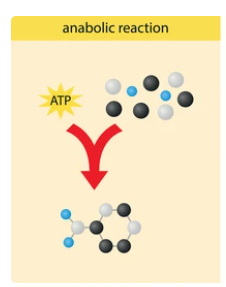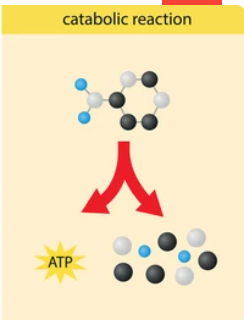
The decomposition of complex organic compounds into simpler compound with the help of enzyme is known as:
(A) Catabolism
(B) Anabolism
(C) Fermentation
(D) Metabolism
Answer
222.3k+ views
Hint: You must know what each of the processes given in the above options is used for. By checking each option one by one try to eliminate the options and try to find out the answer by this method.
Complete Step by Step Solution:
Metabolism comprises of two type of reactions or processes one is catabolism and the other one is anabolism. Metabolism is basic set of reactions taking place in any living cell. During anabolism smaller micro molecules combine to form larger macro molecule, in this something is formed from smaller particles. In such processes energy is utilised. Photosynthesis is an anabolic process.
This image shows anabolism

Therefore option (B) is incorrect.
Also metabolism includes anabolism as well so option (D) also cannot be the answer.
Now, catabolism means breakdown of larger macromolecules into simpler small micro molecules. Respiration is a catabolic reaction. In such reactions or processes energy in the form of ATP is released.
This image shows catabolism

Hence, option (A) is the correct answer.
Both catabolism and anabolism must be present together in a living cell for the cell to be actually living, that is metabolism is one of the defining factor for a cell to be called actually living.
Fermentation occurs in yeast cells and bacterial cells. It is a reaction in which glucose is broken down. Therefore option (C) is also not the correct answer.
Note: Note that in fermentation also organic compounds are broken down into simpler substances but this reaction itself is classified under broad heading of catabolism that is fermentation is also a catabolic process.
Complete Step by Step Solution:
Metabolism comprises of two type of reactions or processes one is catabolism and the other one is anabolism. Metabolism is basic set of reactions taking place in any living cell. During anabolism smaller micro molecules combine to form larger macro molecule, in this something is formed from smaller particles. In such processes energy is utilised. Photosynthesis is an anabolic process.
This image shows anabolism

Therefore option (B) is incorrect.
Also metabolism includes anabolism as well so option (D) also cannot be the answer.
Now, catabolism means breakdown of larger macromolecules into simpler small micro molecules. Respiration is a catabolic reaction. In such reactions or processes energy in the form of ATP is released.
This image shows catabolism

Hence, option (A) is the correct answer.
Both catabolism and anabolism must be present together in a living cell for the cell to be actually living, that is metabolism is one of the defining factor for a cell to be called actually living.
Fermentation occurs in yeast cells and bacterial cells. It is a reaction in which glucose is broken down. Therefore option (C) is also not the correct answer.
Note: Note that in fermentation also organic compounds are broken down into simpler substances but this reaction itself is classified under broad heading of catabolism that is fermentation is also a catabolic process.
Recently Updated Pages
Types of Solutions in Chemistry: Explained Simply

States of Matter Chapter For JEE Main Chemistry

Difference Between Alcohol and Phenol: Structure, Tests & Uses

Conduction Explained: Definition, Examples & Science for Students

Balancing of Redox Reactions - Important Concepts and Tips for JEE

Atomic Size - Important Concepts and Tips for JEE

Trending doubts
JEE Main 2026: Application Form Open, Exam Dates, Syllabus, Eligibility & Question Papers

Derivation of Equation of Trajectory Explained for Students

Hybridisation in Chemistry – Concept, Types & Applications

Understanding the Angle of Deviation in a Prism

How to Convert a Galvanometer into an Ammeter or Voltmeter

Degree of Dissociation: Meaning, Formula, Calculation & Uses

Other Pages
Solutions Class 12 Chemistry Chapter 1 CBSE Notes - 2025-26

NCERT Solutions For Class 12 Chemistry Chapter 1 Solutions - 2025-26

The D and F Block Elements Class 12 Chemistry Chapter 4 CBSE Notes - 2025-26

NCERT Solutions for Class 12 Chemistry Chapter Chapter 7 Alcohol Phenol and Ether

NCERT Solutions ForClass 12 Chemistry Chapter Chapter 8 Aldehydes Ketones And Carboxylic Acids

JEE Advanced Marks vs Ranks 2025: Understanding Category-wise Qualifying Marks and Previous Year Cut-offs




